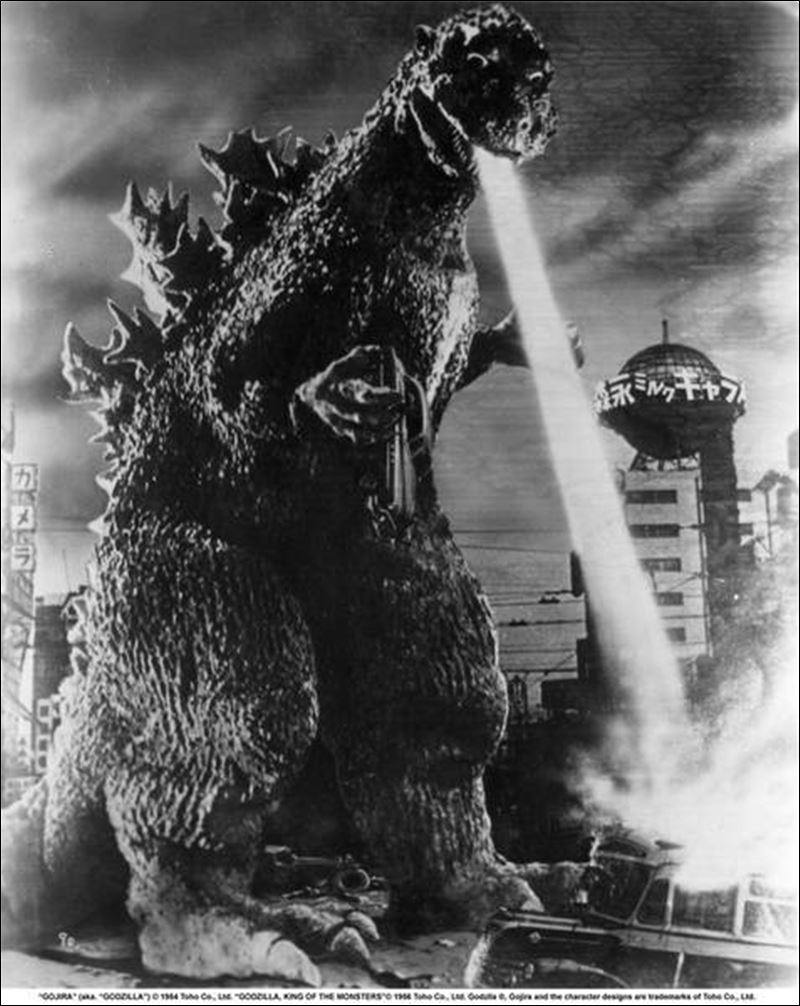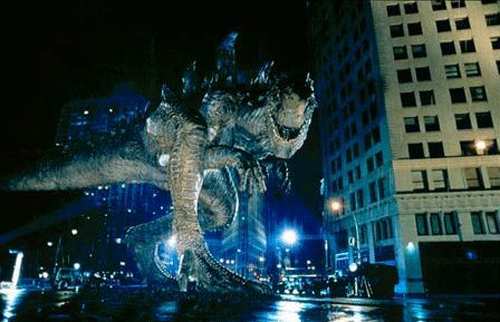In 1953 The Beast From 20,000 Fathoms debuted, it featured a fictional Rhedosaurus released from its icy tomb in the Arctic by a nuclear bomb, it then goes on a rampage in New York. It's believed to have travelled to America because that's where fossils of the Rhedosaurus was found, it's acting on homing insticts. When injured its blood is revealed to carry a prehistoric germ that leads to more fatalities. In the end the beast in killed in a showdown on Coney Island, defeated when a radioactive isotope is shot into it, burning and killing it from within. Based on the short story The Fog Horn, contained in the short story collection The Golden Apples of the Sun by author Ray Bradbury ( Fahrenheit 451, The Halloween Tree), with special effects by Ray Harryhausen (Jason and the Argonauts, Clash of the Titans) and directed by Eugène Lourié (Behemoth, the Sea Monster/ The Giant Behemoth, 1959, Gorgo, 1961, and Krakatoa, East of Java, 1969).
The film was to be the first of many, starting a trend of monsters connected to atomic bombs, one of which was the infamous Godzilla, which followed in 1954.
Godzilla in 1954 was the first of many Kaiju films (Kaiju means 'strange creature' though most people accept it as monster). Known as Gojira and edited in 1956 as Godzilla, King of the Monsters!, with footage of American actor Raymond Burr mixed into it. Gojira was a prehistoric beast freed by an American Hydrogen bomb. He went on a rampage through Tokyo destroying people not just with his size and strength but his atomic nuclear, fire like breath, and nuclear poisoning. Godzilla represented an allegory for the nuclear damage Japan had experienced first hand with Hiroshima and Nagasaki.
A monster that was designed to resemble the Tyrannosaurus Rex, Iguanodon, and Stegosaurus combined, over the years he not only changed in shape and size and developed more powers but he also stopped being a villain and instead became a defender of Japan against other kaiju.
The film spawned many sequels, the last of which was in 2004- Godzilla: The Final Wars, an American remake in 1998, and the promise of an American rebooting in 2014.
The 1998 version starring Matthew Broderick and Jean Reno was a financial success though fans and critics loathed it, and the monster featured has since been dubbed Zilla. In the film nuclear testing in French Polynesia leads to an Iguana egg becoming mutated, decades later and the result is Godzilla. Godzilla goes to New York city and ravages it, apparently its desire is to make a nest there in Manhattan, it succeeds in laying hundreds of eggs, which are destroyed by explosives. Godzilla becomes trapped in the steel cables of the Brooklyn Bridge and is destroyed by the military. An egg is then revealed to have survived and hatched, leading into the spin-off cartoon series. Zilla also made an appearance in Final Wars during which he and Godzilla briefly fought and he was defeated.
Behemoth the Sea Monster, directed in 1959 by Eugène Lourié it bears many similarities to his earlier flick The Beast from 20,000 Fathoms, this time nuclear testing leads to a monster appearing from the ocean near England. A fictional Paleosaurus, he rampages through London, becomes entangled in an electric fence like Godzilla only to have the electric make him stronger and is killed by an anti-nuclear cadmium isotope bullet, which causes him to disintegrate. Just as with the ending of Godzilla there is a pondering of humans having made the creature and the possibility of another appearing.
Next in Lourié's monster trilogy was 1961's Gorgo, which was also set in London. After a volcano erupts and carcasses of sea life start showing up, fishermen investigate and are attacked by a monster. The monster is captured and sold to a circus in London, after being examined by scientists it is determined that this monster is a baby. Gorgo's monster mother Ogra soon comes looking for him and London is devastated in their wake before they escape and return to the sea. The film inspired a comic book series and a novelisation.
It borrowed some aspects from 1933's King Kong, in which the giant gorilla is captured and put on display for humans in Manhattan before escaping and infamously getting shot down from the Empire State Building.
King Kong is ones of the earliest examples of a monster movie, featuring not just Kong but several dinosaurs on th uncharted Skull Island and the strange and tragic love of the gorilla for leading lady Ann Darrow. It earned two remakes, one in 1976 and one in 2005, and Kong himself did battle with Godzilla in Japan's 1962 flick King Kong Versus Godzilla.
The special effects for King Kong were created by Willis Harold O'Brien who also did work for 1925's silent stop motion flick The Lost World, based on the Sir Arthur Conan Doyle novel of the same name, and 1949's Mighty Joe Young, Ray Harryhausen did a lot of work on the latter. Mighty Joe Young was remade in 1998 and The Lost World was remade in 1960, 1992 (with a sequel in the same year), 1998, a tv series 1999-2002, and 2001. The original was possibly the first ever film to use stop motion. It draws parallels with King Kong featuring another world within our world which time seems to have forgotten and dinosaurs and other creatures still exist, also like The Land That Time Forgot (a book by Edgar Rice Burroughs, turned into a film in 1975 and remade in 2009), and Journey to the Centre of the Earth (a novel by Jules Verne, made into a film in 1959 and remade in 1978 and 2008).








